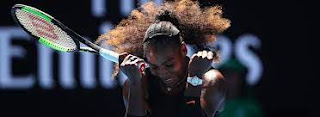THIS 15% CAN MAKE OR BREAK YOUR GAME
What would you do next?
You've rallied strongly and managed to put your opponent under pressure. They've dropped the ball short in the court; it's time to finish the point with an aggressive winner.
Can you finish points like this confidently? Do you finish with a winner, or do you get the jitters and embarrass yourself in front of everyone?
If it's the latter, you're in the majority. The inability to finish points is a problem for tennis players worldwide.
 |
| How well do you react when finishing the point? |
I've coached players of all levels, every level of player suffers from nerves; it's just that the best players somehow have ways to overcome them.
THE MIND SCALE: 0 - 100
I need you to use your imagination for me.
Try to remember what goes on inside your head when you want to attack that half-court ball and hit a winner. Imagine that your thoughts are like a straight line.
Picture a mental scale in your mind from 0-100. 0 is when you decide to attack the half-court ball, and the finish is 100 on the scale.
 |
| Most players are ok for 85% of the mid-court put-away, it's the last 15% where we fail |
Most players are ok mentally for 85% of the execution. It's only at the end of our mental scale that things start to go wrong quickly. It's that last 15% of the "mental line" when things turn ugly!
It, therefore, makes sense that we should put all our mental effort into that last 15%. Get the last 15% right, and you'll complete the point successfully.
WHAT TO THINK
Having decided that the most stressful part to master is the last 15%, we now need to find a solution to the mental meltdown that occurs during this moment.
We can either occupy the mind (distract it) or train the mind to master the problem.
I've always believed that the Western method of dealing with mental problems is primarily through distraction.
Timothy Gallwey's book The Inner Game of Tennis is based on distracting the mind through various methods. Most notably, his suggestion to verbally say "bounce" as the ball bounces on your side of the net and "hit" when you strike the ball.
 |
| Timothy Gallwey's book became an became an international bestseller |
This has the effect of focusing the player's mind on two key elements when you rally, anticipation and coordination of the ball.
Eastern philosophy tends to attack the problem differently. Rather than distract the mental issue, it tries to confront it head-on!
TRAINING THE LAST 15%
I want you to tackle the problem front on. Acknowledge that you will become the most nervous just before hitting the ball. Acknowledge it, own it; it's going to happen. Get ready.
There's no point in worrying about that last 15% and trying to ignore it. Be ready for it, and when the jitters come, control yourself by concentrating on the fundamentals.
The fundamentals of finishing are:
- Get the Ball In
Even if you have to take a little speed off the ball or avoid going close to the lines and risk your opponent getting the ball back, get your ball in.
I have coached many players who have subconsciously hit the ball out or in the net on the last ball to avoid playing one more ball.
- Contact
If you want to control a ball, the most effective way to do that is to control your racquet face. Your racquet face will instruct the ball to go high, low, left, or right.
Sounds simple, but under pressure and during the last 15%, you can do weird things with your racket face. Your fear can stop you from hitting through the ball and giving the ball the proper instructions.
During the last 15%, the ball needs clear instructions. Let the racquet-face do its job.
- Timing
Do you feel more clumsy during the jitters?
If you do, that's because your focus went to the "mistake," and you didn't stay focused on your technique.
Whenever I watch one of my players come forward to finish a mid-court ball, I watch their footwork, especially how they create timing from the ground. If they start to look clumsy and off-balance, I worry about them finishing successfully.
During that last 15%, focus on timing the ball well, and you'll almost always control it well also.
The last part to work on is exposing yourself to the previous 15% as many times as possible. I cover getting accustomed to playing under pressure with my 3am Theory training methods.
Play lots of points and put yourself under pressure to finish the point. The more times you can "practice" the last 15%, the better you will be in a match.
Remember, it's not possible to rid yourself of the jitters completely. The better you become as a player, the more stressful your matches become. The pressure increases.
You can confront the finishing jitters and learn to control them. Control the last 15%, and you've gone a long way to mastering the art of finishing points like a boss.



%20copy.png)

Comments
Post a Comment